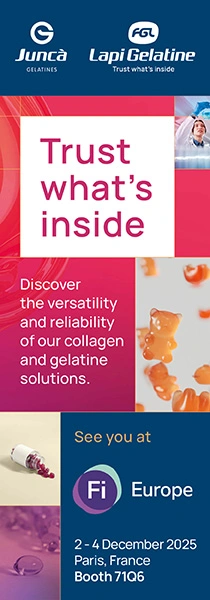Jungbunzlauer webinar preview: Harnessing gellan gum for next-gen plant-based beverages
Key takeaways
- Gellan gum stabilizes cocoa, plant proteins, pulp, and other particles without affecting mouthfeel.
- Ultra-low use levels outperform alternatives, reducing cost and environmental footprint.
- Ideal for plant-based milks, functional waters, and hybrid beverages, with simple regulatory compliance globally.
As consumer expectations evolve, formulation challenges do, too. According to Jungbunzlauer, a Swiss-based global leader in producing biodegradable ingredients derived from natural sources, one of the most pressing challenges in plant-based beverages is maintaining the suspension and sensory appeal of insoluble particles.
With plant-based product development becoming increasingly complex, gellan gum stands out as a multifunctional, label-friendly ingredient that addresses modern food and beverage systems’ stability, sensory, and processing needs.
Whether it suspends insoluble particles, stabilizes cocoa, or creates rich and resilient foams, gellan gum delivers consistent performance with a low environmental and formulation footprint, says the company. Jungbunzlauer is spotlighting gellan gum’s uses as a key ingredient in beverages in a forthcoming webinar, scheduled to be broadcast on October 16, 2025.
Ahead of the webinar, Food Ingredients First speaks with Iliana Nava, market development manager, Americas, at Jungbunzlauer.
How does gellan gum let formulators fine-tune fluid-gel suspensions so they stay evenly dispersed through heat treatment methods and shelf life?
Nava: Gellan gum’s molecular structure allows the formation of a fluid gel network that maintains particles in suspension without affecting mouthfeel. This is especially important for beverages with insoluble particles like cocoa, plant proteins, or pulp. Gellan gum is highly stable in various processing conditions, temperatures, and pH, and maintains suspension and functionality.

In plant-based milks, what inclusion levels and ion management consistently prevent sedimentation without chalky mouthfeel — and how do you troubleshoot when viscosity creeps up?
Nava: In plant-based milks, the High Acyl (HA) grade of gellan gum is recommended due to its suspension and stability properties, without the need for ions to form the fluid gel network. Although no ions are required for HA gellan, it is important to identify a use level that provides the right stability, depending on the ingredients and type of dairy alternative beverage. A good use level can range from 0.03%-0.035%. Anything above may start providing excessive structure, and an undesirable soft gel may be obtained. On the other hand, levels below 0.03% may not provide proper stability and lead to sedimentation or flotation of particles.
Where does gellan gum outperform alternatives like carrageenan, pectin, or microcrystalline cellulose (MCC) for next-generation beverages, and when is a hybrid system the smarter choice?
Nava: Gellan gum provides excellent stability without affecting the mouthfeel or viscosity of dairy alternative beverages. It is also considered a label-friendly ingredient, which could replace less desirable ingredients such as carrageenan. Also, gellan gum can be combined with pectin to achieve superior stability and suspension in lower pH or acidified dairy alternative drinks.
What processing “must-dos” make or break suspension and foam stability at a commercial scale?
Nava: Firstly, gellan gum needs good dispersion and hydration to provide its full functionality. Dispersion can be achieved by dry blending the gum with another granular ingredient in the formula, such as sugar, to separate the particles of gellan gum before adding them to the liquid or water and help prevent clumps during mixing. Then, the dry blend should be added slowly to water with constant mixing and, ideally, high shear.
Secondly, once dispersion has been taken care of, it will be important to achieve a good solubility of the gum. This can be achieved by heating the water or liquid to at least 85°C. Ultra-High Temperature (UHT)/High-Temperature Short-Time (HTST) processes typically have the ability to solubilize gellan gum and will not damage it.
Finally, these steps will ensure that the gum has correctly entered the solution and provides the expected suspension and stability.
How are brands communicating gellan gum on packaging, and what global and/or regional regulatory nuances matter for launches across Europe, APAC, and North America?
Nava: In the EU, gellan gum is approved as “Gellan Gum” or E 418 as an additive. The use level is typically quantum satis [the amount which is enough]. In the US, gellan gum is approved as “Gellan Gum” for direct food addition at GMP level (21 Code of Federal Regulations §172.665). In APAC, gellan gum is also widely accepted as an additive, labeled “Gellan Gum.” Many countries refer to Codex Alimentarius/Joint FAO/WHO Expert Committee on Food Additives (JECFA), where gellan gum is also approved as “Gellan Gum” INS 418.
Given gellan’s ultra-low use levels, what are the real formulation cost trade-offs vs. other hydrocolloids, and how does it impact a beverage’s environmental footprint?
Nava: Gellan gum provides very strong stabilisation and suspending properties at a very low inclusion level. In terms of inclusion concentration and cost-in-use, it can outperform the application of other ingredients. Particular calculations need to be made for a formulation.
You can register for Jungbunzlauer’s webinar titled: “Jungbunzlauer: Don’t settle, suspend: Gellan gum in next-generation beverages” here.














